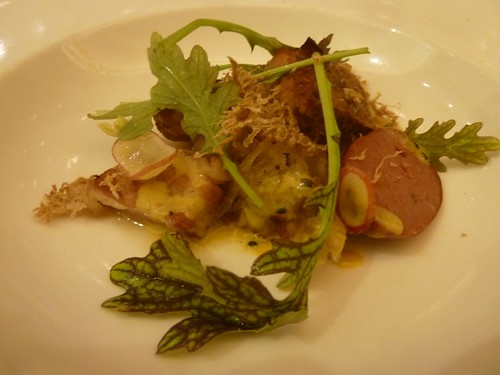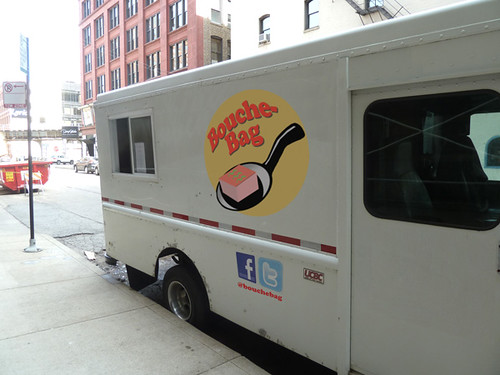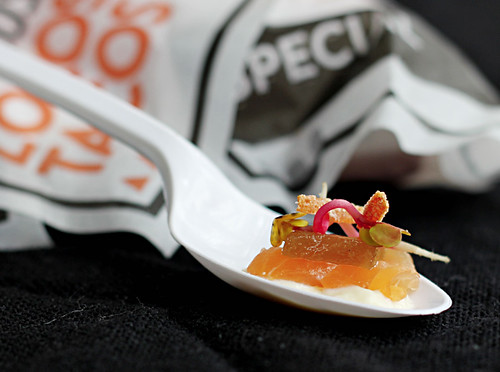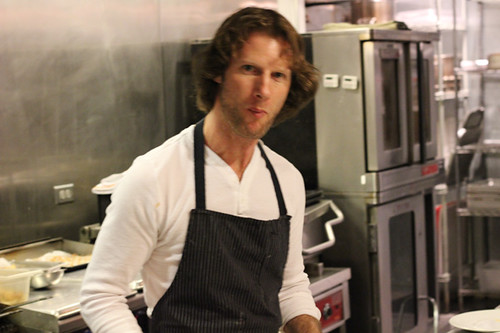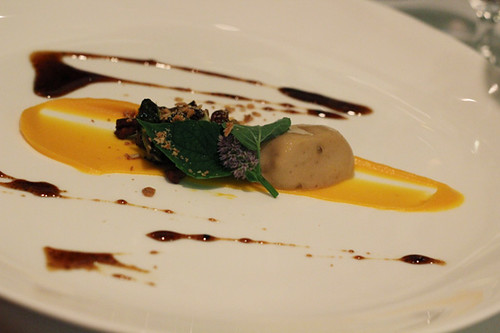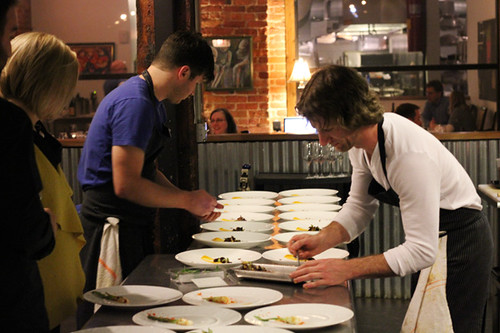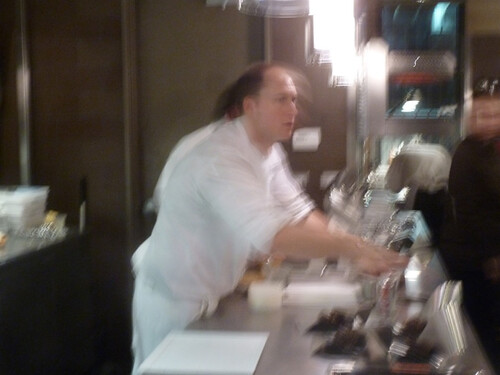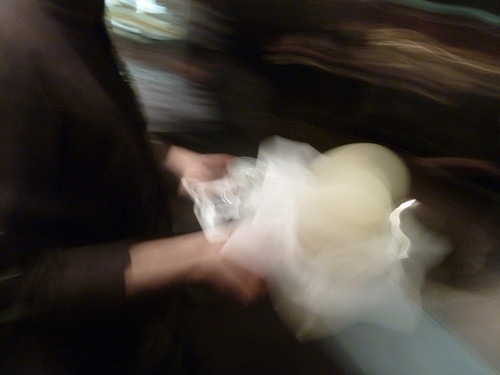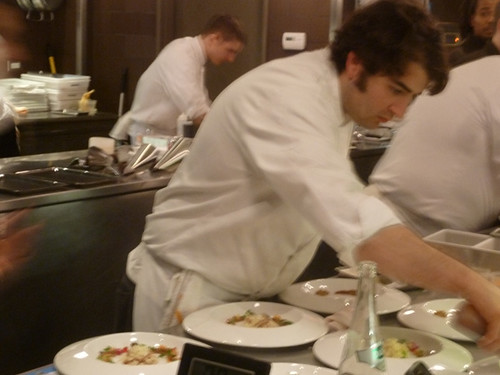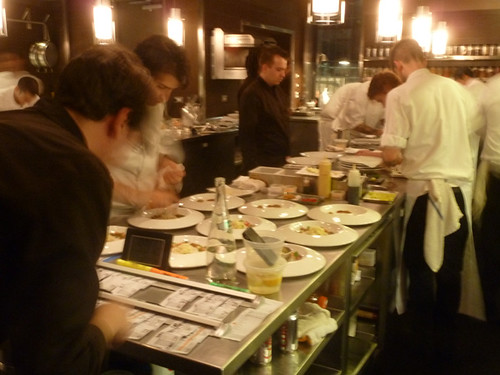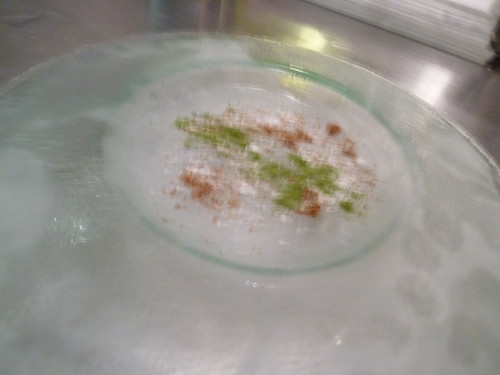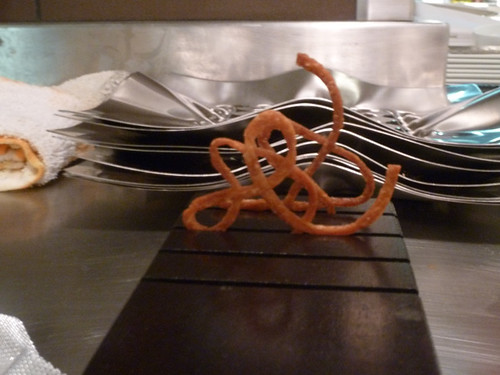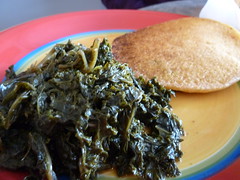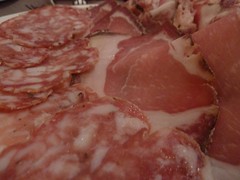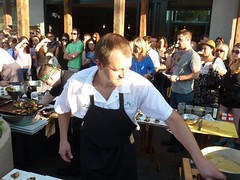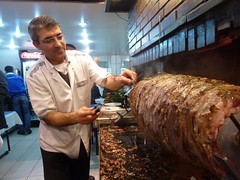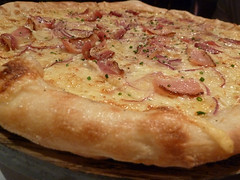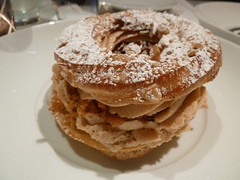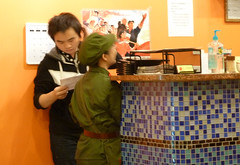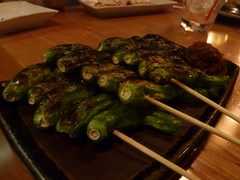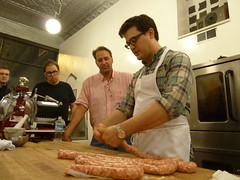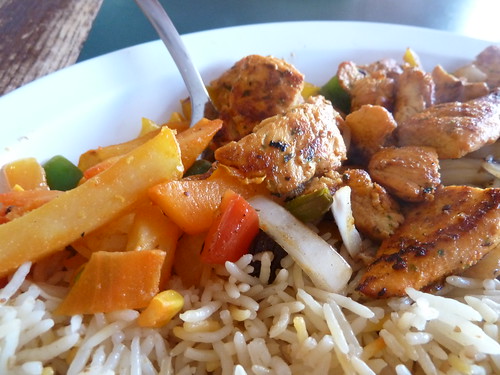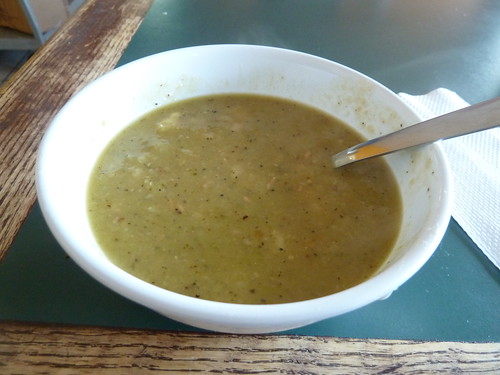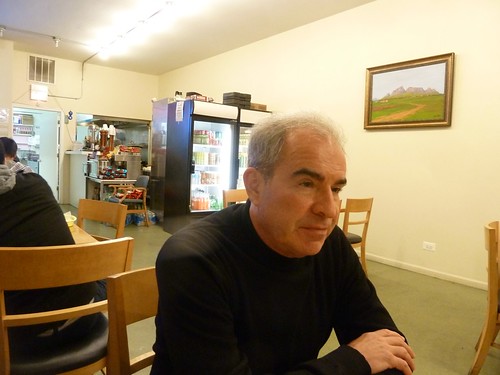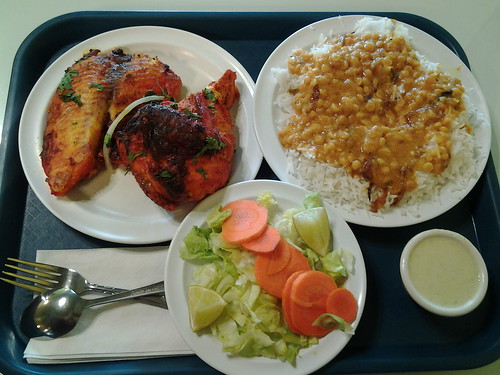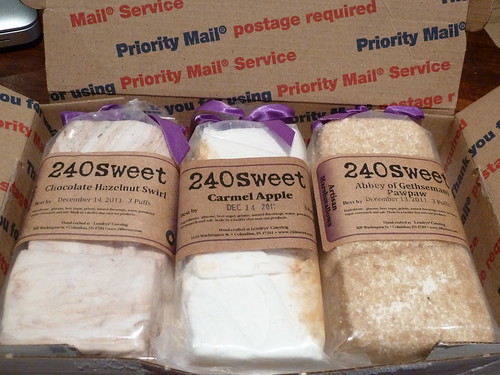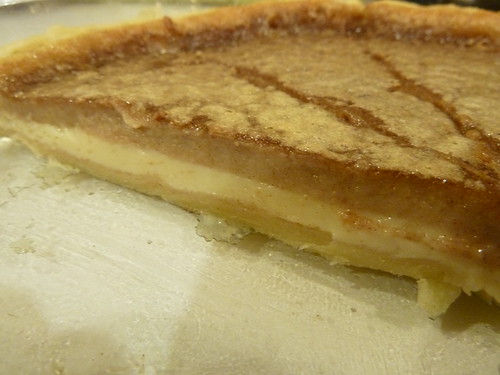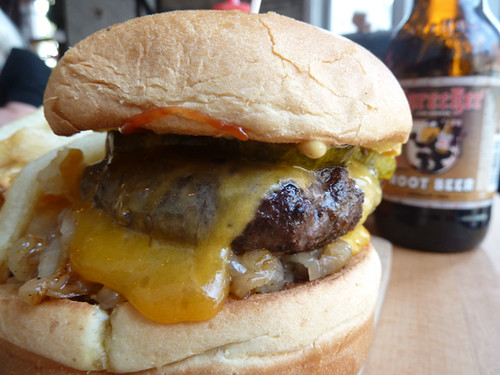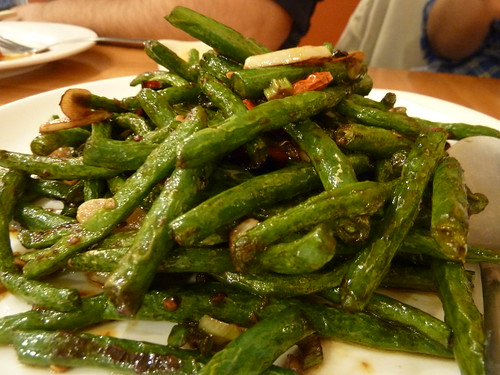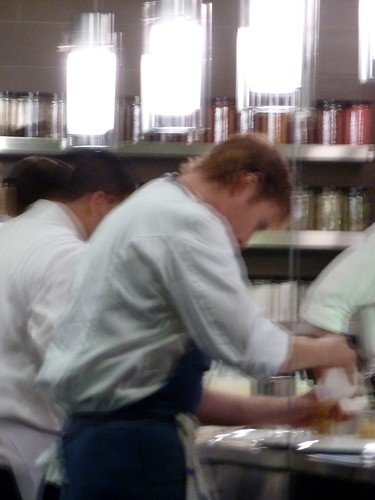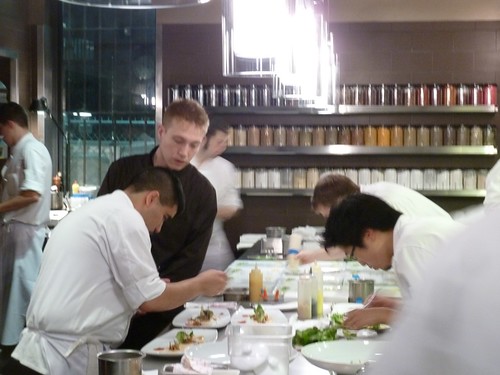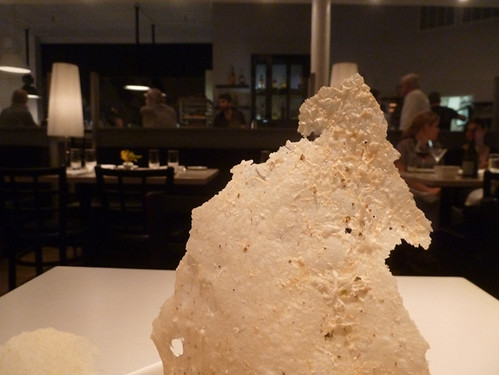
Been to a ton of places lately, haven’t written about them, working backwards through my photos, here’s shortish reviews of a number of them.
Storefront Company— Chic, black and white place on a seemingly unlikely strip near the recent-college-grad drinking epicenter of North and Damen. My first thought was “Blackbird for stroller moms,” but actually given the neighborhood, by the end I was thinking more like Acadia— not that there’s any resemblance between Acadia’s post-industrial-wasteland gentrifying neighborhood and busy-trashy Wicker Park, but there’s a similar mission of, who says you have to go downtown for luxe fancy food and pay crazy prices for it?
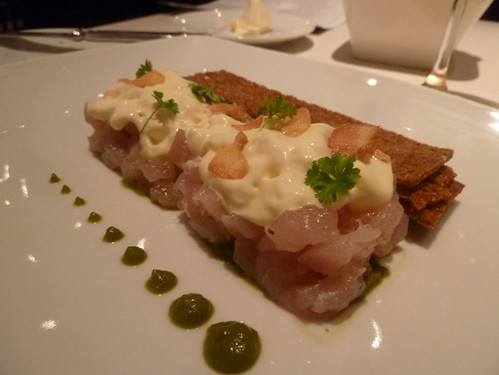
Albacore with clam mousse.
Chef Bryan Moscatello, who was a Food & Wine Best New Chef in Denver and then spent a long time in D.C., makes lush food which looks to impress, but sometimes needed more of a flavor pop to compete with Chicago places, I think— it felt a bit like fancy food from somewhere else. An albacore tartare was gorgeous but the clam mousse on it didn’t have any real taste of the sea to it, damping it down; I did like the boldness of the garlic chips on it, though. A pork cheek hash with gooey six-hour sous-vide egg was the sort of thing where fancy touches don’t bring as much to it as just normal cooking— a diner cook frying the pork and the egg to a little browned crispness would have gotten more flavor out of both. And as far as I’m concerned, six-hour eggs are one of those things, like most malto-dextrin powders, that fall into the “just because you can doesn’t mean you should” camp. (Again, though, there was some daring in the crispy accompaniment on top, which were announced, simply, as what they were: fried chitlins.)
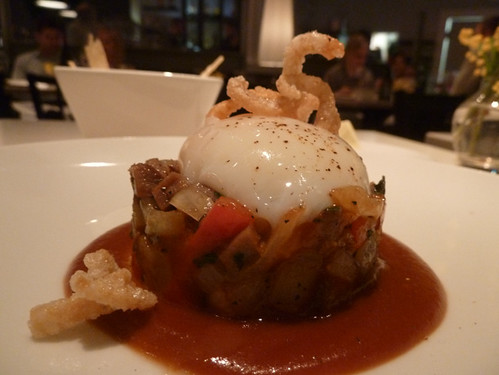
Pork cheek hash with six-hour egg.
But rabbit, treated sort of like a galantine and topped with several generous slices of black truffle, showed that they do know how to sharpen a dish to a flavor point, and though I had resisted the waiter’s fairly insistent pushing of the cheese program, when they sent me out an epoisses anyway (and a glass of white wine to go with it), it was a gorgeous, unabashedly smelly one that blended beautifully with the wine they chose. And the dessert was simply one of the best I’ve had in recent memory, a sweet-savory parsnip cake with cream cheese ice cream, a savory thyme-golden raising sauce, and little dabs of a tart “carrot caramel,” more harmoniously balanced between sweet and savory than you would ever think it could be.
This is an ambitious restaurant way above its neighborhood-place footprint and location— they have their own baking program making breads and mignardises and such, which is more like what a big hotel restaurant would do than a 60-seater in the middle of a block— and even if some of it seemed flash over substance (in a way that you can believe went over in D.C.), it’s at reasonable enough prices that you can afford to experiment to find some undeniable gems. (Disclosure: media dinner, fully comped.)

Parsnip cake.
Urban Union— Do you remember 2008? The heyday of the porky big flavors movement, places like Vie and Mado and Avec making their own salty porcine wonderfulness and putting it in everything, from main courses to vegetables? It’s not that that has exactly gone away, of course, but something about Urban Union, a new place on Taylor Street run by Michael Schrader (formerly of Epic, which I never went to), seemed to bring back those days in a way that wasn’t subtle— there was nothing subtle about the pool of balsamic that my brussels sprouts with pancetta left behind— but was easy to enjoy, and made Urban Union an instant feels-like-it’s-been-there-forever place. (The logo actually says “Est. 1997,” but that’s when Schrader and partner Jason Chan met.)
The downside to this cheerful unsubtlety is that there’s a bit of an unrefined, almost careless feel to some of the dishes— a mussels dish promised something new with Spanish chorizo and so on in it, when it was well-made but pretty standard, and the most interesting dish at first bite, a tagliatelle with pancetta (pancetta’s everywhere), sage and parmesan, was way too salty to eat much of; I suspect it was adjusted for salt before the salty parmesan was added as well. Apparently it takes more a little more effort than this to get effortlessness just right. (Disclosure: none.)
Yusho— I am, apparently, the only person on the entire Chicago food media scene who wasn’t instantly smitten by Yusho, Matthias Merges’ Japanese bar-izakaya-whatever. I went in (on Super Bowl Sunday) prepared to love it, prepared to at last find Chicago’s answer to Yakitori Totto, but it didn’t happen. Oh, there’s no doubt that things are well-made, as you’d expect from a Trotter vet; we sat at the omakase seats overlooking the cooks as three young women spent our entire meal smoothing out chicken skin onto plastic wrap, an unmistakable sign of care (and how boring line cook jobs could be). I don’t doubt the skill and devotion, but things just didn’t taste that great, it was the opposite of Yakitori Totto where the soap in the washroom would have made my ten best list. I don’t remember all that much now, but take the fried chicken, big chicken fingers (that’s whose skin we were watching being flattened) fried like fried chicken and then dashed with some green nori-type powder. Some people love it; to me it was like dipping my chicken fingers in the goldfish’s food.
Nothing was that great until we got to dessert— and suddenly the place blossomed for me. I loved a dessert built around a custard made from kalamansi, a tart Asian citrus; and a tongue-pricking Sichuan peppercorn frozen custard. With so much acclaim from every corner I’ll try Yusho again— but I’m willing to do that because I know if nothing else, there will be a reward at the end. (Disclosure: none.)

Mi quang noodles.
Nha Hang— Once in a while LTHForum takes time off from criticizing the reservation process at Next to work the way it was designed to work, and this one end-to-the-other exploration of Vietnamese food on Argyle street was one of the best examples in recent memory. The clear winner and new discovery to come of the effort was this family-run spot near the eastern end of the strip, and trying some of the LTH-scouted things, it’s quite good— I especially liked rare (it wasn’t, but never mind) beef salad, which had a Thai food-like limey-juiciness, woven rice wraps with terrific grilled beef and shrimp, and bun mam, a rich broth soup. (The one LTH recommendation I tried and was just okay on was the Mi quang noodles; curry-flavored noodles with lots of peanut, it just tasted like middling pad thai.)
The only caveat I’d add to the chorus of LTH praise is that while I liked the cleanness of the broths and flavors, which was almost Japanese in its purity, I also kind of like some funk in my Asian soup, or a lot of funk in it, and this isn’t the place for that so far as I could see. So it doesn’t replace, say, the bun bo hue at Cafe Hoang (thanks Dan Schleifer for the tip), which is almost satanically, Ike Turner-funky by comparison. LTH has a tendency to settle on one place as the place for a cuisine, to the detriment of seeking out others; Tank Noodle was it for Vietnamese for years, and I think the proper response to discovering Nha Hang is not to topple Tank and crown Nha Hang in its place, but to take the lesson, enjoy Nha Hang as presenting one side of the cuisine very well— and keep hunting.
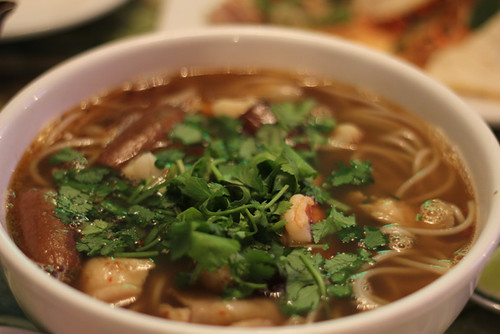
Bun mam.

Jimmy’s Pizza Cafe & Beignets— Clean flavors were also the hallmark of another place nominated for an LTHForum Great Neighborhood Restaurants award this season, a New York-style pizza cafe on north Lincoln (which for some reason has New Orleans-style beignets, covered in literally a quarter inch shelf of powdered sugar). It’s a nice bready New York-style crust, but seemed a little bland to me while I was eating it. I have to say, though, it’s stuck with me since then; in a town of gutbomb pizzas that stomp a place into your stomach, this one steps as lightly as a ballerina, and that’s worth rewarding. We had both a freshly made pizza and a reheated slice of white (pesto and ricotta) pizza, and both were worthy.
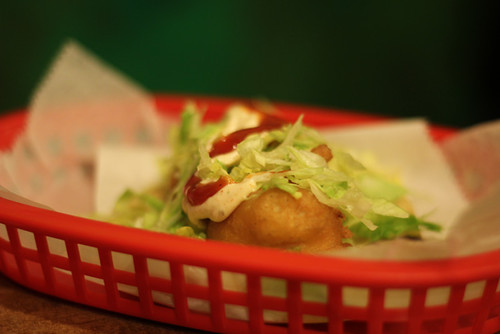
La Lagartija— West or near south side taqueria-bar, you wouldn’t say upscale but a notch up from taqueria in ambience, owned by the Bombon Bakery couple. The question with any place selling $3 tacos is, are you getting a better taco in some way for that money over the found-everywhere $2 Chicago taco, or is more money actually buying you a less interesting, gringo-safe taco? La Lagartija just manages to come in on the better side, in part because it uses good toothy Chicago tortillas like a $2 taco would. Steak and pastor tacos were all right, you can get better for $2, but you will probably eat a lot of worse ones trying to find them. The best thing, as LTHers say and they are correct, is the shrimp taco, a bit too much goo on top for my taste, but good quality shrimp lifted this above the average.

La Chapparita #1— One of the things that was cool about LTHForum back in the day was how different people would discover similar things by different methods. I went looking for Supermercado Taquerias a couple of years ago by driving down major streets looking for awnings that suggested tacos might be made inside— but I never would have found this taqueria in a grocery/candy store, on thoroughly residential 25th street, that way; instead another old-timer found it by chatting up strangers and asking for their suggestion of their favorite taco spot. But however you found it, it’s a find— a vaguely spooky Day of the Dead themed taqueria turning out beautifully well-made tacos of all kinds. I stuck to things you don’t find elsewhere (longaniza, or sausage, lengua or tongue which is served as a whole slice, not chopped, and tripas, which is actually not tripe but chitlins— you want to order them crispy) and they were all exemplary, full of flavor and executed to a T. A place like this is why good $3 tacos are worth paying for, but the great $2 tacos are a gift from the angels to us mortals.
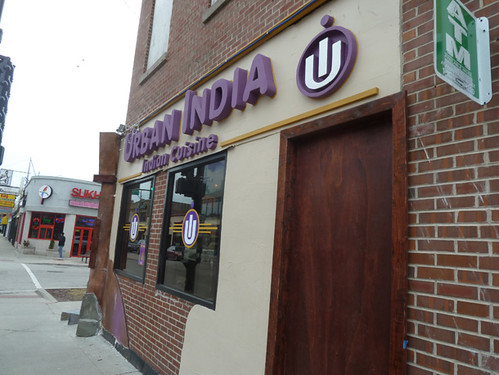
Urban India— Urban or Union is in half of new restaurant names these days, so it’s not that surprising that a new place on Devon with what looks like a little younger feel (like Uru-Swati, kind of coffeehouse-ish) would be called Urban India. The most promising thing to me was the fact that it smelled like woodsmoke— like there’s actual wood in their tandoor. There may be, but alas, it didn’t come through nearly as strongly as I would have liked on the tandoori chicken. That disappointment aside, I thought everything was pretty well made and of good quality… but it was also quite pricey for Devon ($12.95 for tandoori chicken is on the high side, but $11.95 for sag paneer, which is probably $5-8 elsewhere on the strip, is wacky; a little artfulness with the ginger hardly justifies the difference).

That’s-a-Burger— Burgers in the midwest are nearly always freshly-ground, and even an okay one in a place like Indiana or Oklahoma or Kansas is usually pretty damn good as a result. The exception to that was Chicago, where they used to nearly all be the frozen hockey-puck burger kind. The exception to that was always a small number of fresh patty places on the south east side of Chicago, both white (Top-Notch Beefburger) and black-run (That’s-a-Burger), which maybe because of proximity to Indiana, insist on fresh-ground meat against the tide of the hockey puck. With all our artisanal burger places (Edzo’s, Epic Burger, The Butcher & Burger, whatever) the need to go run and eat a burger on 71st street from a place where there’s no seating, you order through bulletproof glass, it takes an absurdly long time (about half an hour) to get your burger and the (black) owner plays rightwing talk radio really loud and will kick your ass if he catches you taking a photo, is maybe not that apparent. It’d be so much easier to just go eat a yuppie burger on Armitage, say. But trust me, you need to do this once, and then you need to go right back to your car and eat it immediately; it makes a big difference. What was I just saying about clean flavors versus Ike Turner funk? Yeah, here too. This is a burger that tastes like stockyards. Like a ten-hour shift. Like blood and onions in the air. Like Chicago, not some candy-ass yuppie burger. That’s-a-Burger, muthaf–….

Barbecued shoat.
Big Jones— This was a special dinner, not off the regular menu, but given its fair chance of making my ten-best this year, I should mention it now. The meal was the Kentucky tavern bourbon dinner, c. 1840s. I like Big Jones, I don’t necessarily think it’s great great, but it makes likable food that’s usually a pretty good example of Southern classics, and if you want fried chicken or shrimp and grits in a more upscale atmosphere than Feed or Wishbone and with a cocktail, it’s a happy, easygoing place to be. It’s also a place that seems to make things you expect to love but don’t, quite, more often than it should by now.
But chef Paul Fehribach has been digging diligently into old cookbooks for themed dinners, and the chance to make oddball, deeply uncommercial things like calves’ foot jelly seems to take Big Jones to a new level, where it doesn’t have to hit anyone’s preconceptions of “restaurant food” but can just be its own rustic, strange self. Some of these are incredibly simple (hominy, barbecued shoat or young pig), some of them reintroduce unfamiliar flavors (the surprisingly sweet calves’ foot jelly, pearl onion and mutton cream soup, a rosewater dessert). At this dinner, a few were flat-out great dishes (the mutton soup in particular) and all of it was a trip to an unfamiliar world. During the meal Fehribach was playing the Harry Smith Anthology of folk music, which collected the backwoods music of, in Smith’s words, “the old, weird America.” This was the food of the same place, and I can’t wait to go back. (Disclosure: none.)

Bourbon and calves’ jelly.
Keefer’s— I am not a steakhouse guy. I admit that freely. I do not find just a big hunk of meat accompanied by a couple of WASP vegetables (a baked potato or broccoli) to be interesting enough for a fancy meal. I went to one a while back courtesy of its PR people, and they kind of hinted at hoping I would post something, and I just thought… I have nothing to say beyond “very nice steak.” So it’s something that I actually had a couple of things at Keefer’s that motivate me to write. As my dining companion Kennyz noted, the Nantucket bay scallops were served in butter that was browned to the point of being mahagony— kudos to chef John Hogan, who many years ago had Savarin, for being willing to brown it that dark, but they were great. And we shared a veal chop, which I’ve thought of fondly many times since for the pure simple flavor of roasted meat and juicy saltiness. Other things reminded me why I’m just not into that food (the 1940s believed that a fillet of fish was improved by being stuffed with bread crumbs and crabmeat, I pretty much believe the exact opposite) but if someone were to ask me for a steakhouse recommendation, after expressing my doubts about the wisdom of asking me, I would steer them toward Hogan’s slightly more varied menu and mastery of classic American chophouse technique happily. (Disclosure: media dinner, fully comped.)
Tags:
big jones,
Jimmy's Pizza,
Keefer's,
La Chapparita #1,
La Lagartija,
Nha Hang,
Storefront Company,
That's-a-Burger,
Urban India,
Urban Union,
Yusho
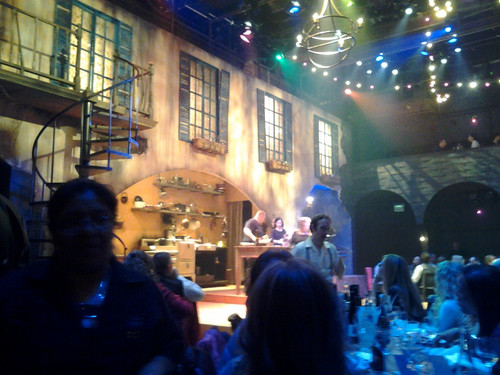
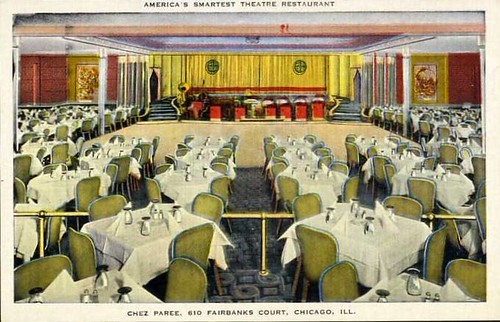


 Posted in
Posted in 


